Middle-distance running events are track races longer than sprints, up to 3000 metres. The standard middle distances are the 800 metres, 1500 metres and mile run, although the 3000 metres may also be classified as a middle-distance event. The 1500 m came about as a result of running 3+3⁄4 laps of a 400 m outdoor track or 7+1⁄2 laps of a 200 m indoor track, which were commonplace in continental Europe in the 20th century.
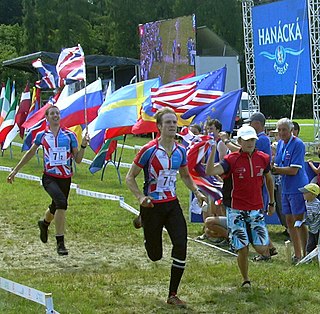
A relay race is a racing competition where members of a team take turns completing parts of racecourse or performing a certain action. Relay races take the form of professional races and amateur games. Relay races are common in running, orienteering, swimming, cross-country skiing, biathlon, or ice skating. In the Olympic Games, there are several types of relay races that are part of track and field. Relay race, also called Relay, is a track-and-field sport consisting of a set number of stages (legs), usually four, each leg run by different members of a team. The runner finishing one leg is usually required to pass the next runner a stick-like object known as a "baton" while both are running in a marked exchange zone. In most relays, team members cover equal distances: Olympic events for both men and women are the 400-metre and 1,600-metre relays. Some non-Olympic relays are held at distances of 800 m, 3,200 m, and 6,000 m. In the less frequently run medley relays, however, the athletes cover different distances in a prescribed order—as in a sprint medley of 200, 200, 400, 800 metres or a distance medley of 1,200, 400, 800, 1,600 metres.

Road running is the sport of running on a measured course over an established road. This differs from track and field on a regular track and cross country running over natural terrain.

An ultramarathon, also called ultra distance or ultra running, is any footrace longer than the traditional marathon length of 42.195 kilometres. Various distances, surfaces, and formats are raced competitively, from the shortest common ultramarathon of 31 miles (50 km) and up to 3100 miles. World Championships are held by the International Association of Ultrarunners (IAU) for 50 km, 100 km, 24 hours, and ultra trail running. The Global Organization of Multi-Day Ultramarathoners (GOMU) holds World Championships for 48 hours and 6 days. World Records are ratified and recognized by World Athletics, the IAU, and by GOMU.

Endurance racing is a form of motorsport racing which is meant to test the durability of equipment and endurance of participants. Teams of multiple drivers attempt to cover a large distance in a single event, with participants given a break with the ability to change during the race. Endurance races can be run either to cover a set distance in laps as quickly as possible, or to cover as much distance as possible over a preset amount of time.

Trail running is a type of running that takes place on outdoor trails, often in mountainous terrain, and often includes significant ascents and descents. Trail running is overseen by the International Trail Running Association (ITRA) and includes longer races.
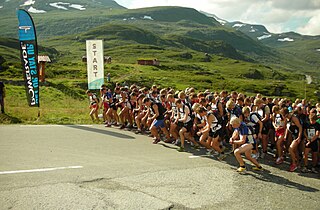
Fell running, also sometimes known as hill running, is the sport of running and racing, off-road, over upland country where the gradient climbed is a significant component of the difficulty. The name arises from the origins of the English sport on the fells of northern Britain, especially those in the Lake District. It has elements of trail running, cross country and mountain running, but is also distinct from those disciplines.
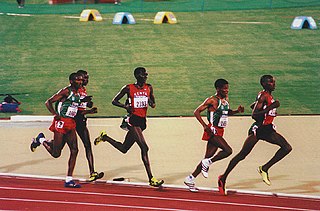
The 10,000 metres or the 10,000-metre run is a common long-distance track running event. The event is part of the athletics programme at the Olympic Games and the World Athletics Championships, and is common at championship-level events. The race consists of 25 laps around an Olympic-sized track. It is less commonly held at track and field meetings due to its duration. The 10,000-metre track race is usually distinguished from its road running counterpart, the 10K run, by referring to the distance in metres rather than kilometres.
A 12-hour run is a form of ultramarathon in which each competitor tries to run as far as possible in 12 hours. The event is typically held on 1 to 2 mi loops, but sometimes is held on 400-metre (0.25 mi) tracks. Some races are held on trails and others are held on sidewalks in city parks. Top runners will often run 60 miles (97 km) or more, depending on conditions. Some participants will have a crew to help them, while others set up a camp with their equipment and supplies near the starting area, with good access from each loop.
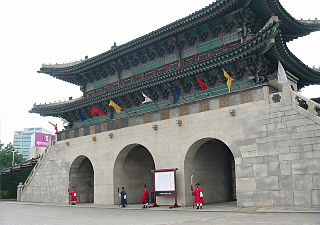
The Seoul International Marathon, also known as the Dong-A Ilbo Seoul Marathon or Seoul Marathon is an annual marathon race that takes place in Seoul, South Korea. It is one of two annual races over the 42.195 km classic distance in the city, alongside the JoongAng Seoul Marathon which is held in November. It holds World Athletics Platinum Label Road Race status. First held in 1931, it is the third longest-running road running competition in Asia after the Hakone Ekiden and Chugoku Yamaguchi Ekiden in Japan.
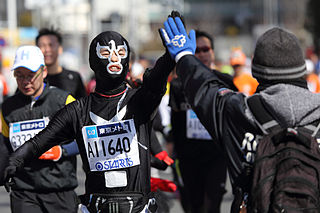
The 2013 Tokyo Marathon was the seventh edition of the annual marathon race in Tokyo, Japan and was held on Sunday, 24 February. An IAAF Gold Label Road Race, it was the first World Marathon Majors event to be held that year and represented the first occasion that the Tokyo race was part of the elite-level marathon series.
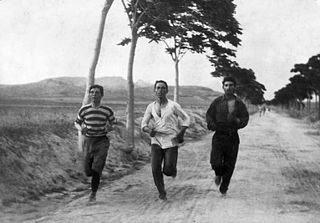
The marathon at the Summer Olympics is the only road running event held at the multi-sport event. The men's marathon has been present on the Olympic athletics programme since the first modern Olympics in 1896. Nearly ninety years later, the women's event was added to the programme at the 1984 Olympics in Los Angeles.

Ellie Greenwood is a British and Canadian ultramarathon runner. She is a four-time 100km World Champion, winning both individual and team titles in 2010 and 2014. She won the 90 km Comrades Marathon in South Africa in 2014, becoming the first British woman to win the race. Greenwood is also a former champion and course record holder for the Canadian Death Race, Western States 100, and the JFK 50 Mile Run.
Eleanor Robinson is a British former ultramarathon runner and two-time winner of the IAU 100km World Championships. She was the first woman to run over 150 miles in a 24-hour endurance race. She was the winner of the first Badwater Ultramarathon in 1987. She was twice bronze medallist at the IAU 100 km European Championships.
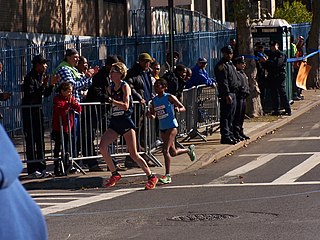
Jacquelyn Camille Herron is an American ultramarathon runner, scientist, coach, and a four-time International Ultrarunner of the Year. She is the first and only athlete to win all three of the road IAU World Championships for 50K, 100K, and 24 Hours. In 2017, she became only the third American to win the Comrades Marathon and later broke Ann Trason's 100-mile Road World Record by over an hour in 12:42:40.
The IAU 24 Hour World Championship is an international 24-hour run competition organised by the International Association of Ultrarunners (IAU). Since 2015, the World Championship has alternated annually with the IAU 100 km World Championships.

Katalin Nagy is an ultramarathon runner and member of the USA National 24hr Ultramarathon Team.

Gary Allen is an American long-distance runner, race director and entrepreneur. He is the founder and director of the Mount Desert Island Marathon, the Millinocket Marathon & Half and the co-founder of the Downeast Sunrise Trail Relay and the Great Cranberry Island 50K Ultra Marathon.
The backyard ultra or last one standing is a form of ultramarathon race where competitors must consecutively run the distance of 6.706 kilometres (4.167 mi) in less than one hour, which is a pace of 100 miles per 24 hours. The race is over when only one runner remains to complete a lap. This runner is marked as the winner and only finisher, with all other runners receiving a "DNF". The runner who completes the second-most laps in a race is often referred to as the "assist", in the sense that their effort is ultimately what determines how long the race is allowed to continue--there is no predefined end length or time in a backyard ultra, as long as multiple runners can complete each loop within an hour.

Aleksandr “Sania” Sorokin is a Lithuanian long-distance runner of Russian descent who holds multiple world and European records. As of May 2023, he held seven world records on the track and road: 100 km (road), 100 miles (road), 100 miles (track), 6-hour run (track), 12-hour run (track), 12-hour run (road), 24-hour run (road). Sorokin won the IAU 24 Hour World Championship in 2019, IAU European 24 Hour Championships in 2022 and the Spartathlon in 2017.















